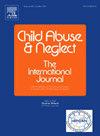按报告人类型划分的涉及学龄儿童的CPS报告的地理空间变化
IF 3.4
2区 心理学
Q1 FAMILY STUDIES
引用次数: 0
摘要
儿童保护服务(CPS)依靠转介儿童虐待来解决虐待和忽视问题。根据报告的虐待类型和社区特征,CPS转诊率在地理上有所不同。目的探讨基于报告类型和地理的CPS转诊率与社区特征之间的关系。我们调查了(a) CPS转诊率与社区水平特征之间的关系,包括这些关系如何因报告者类型而变化;(b)不同地理区域的社区水平特征与CPS转诊率之间的关系。该研究使用了加利福尼亚州2018年至2022年5岁及以上儿童的CPS转介数据。方法根据家庭地址对转介者进行地理编码。对每种报告类型运行回归模型,使用转诊率作为结果和健康场所指数(经济、教育、健康保险、清洁环境、住房、邻里条件、社会、交通、种族构成和城市化)中健康指标的社区层面社会决定因素。采用地理加权回归检验空间异质性。结果不同类型的报告者转诊率与社区水平有不同的关系。群落特征和报告类型确定了空间异质性。变化发生在量级、方向和统计显著性上。结论scps的转诊率因转诊来源和地理区域的不同而存在不同的社区特征。这些发现表明,预防和干预计划可能不会在社区和地区之间普遍有效,强调了在开发和提供此类服务时考虑空间变异性的重要性。本文章由计算机程序翻译,如有差异,请以英文原文为准。
Geospatial variation of CPS reports involving school-aged children by reporter type
Background
Child protective services (CPS) rely on referrals of child maltreatment to address abuse and neglect. CPS referral rates vary geographically in the type of maltreatment reported and community characteristics.
Objective
This study examined the relationship between CPS referral rates and community characteristics, based on reporter type and geography. We investigated (a) the relationship between CPS referral rates and community-level characteristics, including how these relationships vary by reporter type; and (b) the relationships between community-level characteristics and CPS referral rates across geographic areas.
Participants and setting
The study used statewide data from California on CPS referrals for children aged 5 years or older from 2018 to 2022.
Methods
Referrals were geocoded to census tracts based on the family's address. Regression models were run for each reporter type, using referral rate as the outcome and community-level social determinants of health indicators from the Healthy Places Index (economic, education, health insurance, clean environment, housing, neighborhood conditions, social, transportation, racial composition, and urbanicity). Geographically weighted regression was used to examine spatial heterogeneity.
Results
Referral rates had different relationships with community-level characteristics by reporter type. Spatial heterogeneity was identified by community characteristics and reporter type. Variations occurred in magnitude, direction, and statistical significance.
Conclusions
CPS referral rates varied by community characteristics depending on the referral source and geographic area. These findings suggest that prevention and intervention programs may not be universally effective across communities and regions, highlighting the importance of considering spatial variability when developing and providing such services.
求助全文
通过发布文献求助,成功后即可免费获取论文全文。
去求助
来源期刊

Child Abuse & Neglect
Multiple-
CiteScore
7.40
自引率
10.40%
发文量
397
期刊介绍:
Official Publication of the International Society for Prevention of Child Abuse and Neglect. Child Abuse & Neglect The International Journal, provides an international, multidisciplinary forum on all aspects of child abuse and neglect, with special emphasis on prevention and treatment; the scope extends further to all those aspects of life which either favor or hinder child development. While contributions will primarily be from the fields of psychology, psychiatry, social work, medicine, nursing, law enforcement, legislature, education, and anthropology, the Journal encourages the concerned lay individual and child-oriented advocate organizations to contribute.
 求助内容:
求助内容: 应助结果提醒方式:
应助结果提醒方式:


